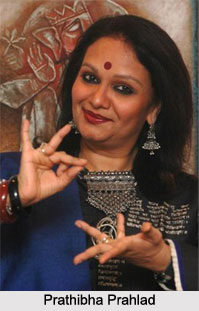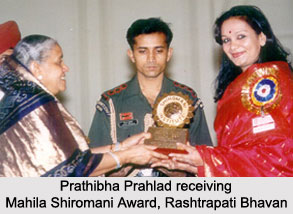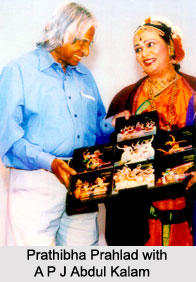 Prathibha Prahlad is a celebrated eminent Indian classical dancer, choreographer, cultural visionary and organiser whose body of work extends much beyond stage performing. Her contribution in the field of performing arts and culture goes beyond her illustrious dance career, which has scaled and touched the prestigious platforms all over the world. Besides being a star performer in Bharatnatyam, she is a cultural visionary whose work is profound and unparalleled in contemporary dance history. Prahlad has had the distinct honour of being the only dancer of her generation to be on an Indian Postal Stamp of Rs. 5.00, released by the Indian Posts & Telegraphs Department, for her extraordinary work in the arts. Most recently in 2016, she has been conferred with the Padma Shri, India"s fourth highest civilian honour, by the Government of India in the field of Art - Classical Dance.
Prathibha Prahlad is a celebrated eminent Indian classical dancer, choreographer, cultural visionary and organiser whose body of work extends much beyond stage performing. Her contribution in the field of performing arts and culture goes beyond her illustrious dance career, which has scaled and touched the prestigious platforms all over the world. Besides being a star performer in Bharatnatyam, she is a cultural visionary whose work is profound and unparalleled in contemporary dance history. Prahlad has had the distinct honour of being the only dancer of her generation to be on an Indian Postal Stamp of Rs. 5.00, released by the Indian Posts & Telegraphs Department, for her extraordinary work in the arts. Most recently in 2016, she has been conferred with the Padma Shri, India"s fourth highest civilian honour, by the Government of India in the field of Art - Classical Dance.
Early Life of Prathibha Prahlad
Prathibha Prahlad was born on January 29, 1962, in the city of Mysore, Karnataka, to Mr. D. R. Prahlad and Mrs. B. S. Prema. She did her schooling at East West School, Bangalore and Srikumaran Children"s School, Bangalore. She later completed Bachelor of Arts from Mount Carmel College, Bangalore and subsequently post graduation in Mass Communication from Bangalore University.
Prahlad started learning Bharatnatyam at the age of 4 under Smt. Sunanda Devi. She later trained in the dance form under Sri Sunder Kumar from 1972 to 1978, Prof. U. S. Krishna Rao and Smt. Chandrabhaga Devi from 1978 to 1986. During this period, she performed widely in Karnataka and the neighbouring states and was hailed a star before she was 20. She continued training in Bharatnatyam from 1984 to 1992 under Smt. Kalanidhi Narayanan and Sri V. S. Muthuswamy Pillai in Chennai and in this period, she also learnt Kuchipudi from Dr. Vempatti Chinna Satyam.
Stage Performances of Prathibha Prahlad
Prathibha Prahlad performed on stage for the first time at the age of 6, in Vijaya High School in Bangalore, however, her first major performance was at the Town Hall, Bangalore, at 8. She did her Ranga Pravesha on January 1, 1977, at Rabindra Kalakshetra, Bangalore. In the year 1991, she was the only Indian dancer invited to perform in the Manila International Dance Festival held in Philippines. In 1993, she performed for India"s opening in the Okayama International Dance Festival, Japan. She also performed in Sydney"s Flute Festival and the Alte Oper, Frankfurt in 1997 and in Nepal in 1998, for the 50th Anniversary of the Republic of India. In 1999, she performed in Sri Lanka, at the International Festival in Bangladesh and for the Independence Day of Fiji and Maldives. She has also had the honour of performing for the United Nations, in Bangkok in 1989 and in New York in 1995.
She also performed in Sydney"s Flute Festival and the Alte Oper, Frankfurt in 1997 and in Nepal in 1998, for the 50th Anniversary of the Republic of India. In 1999, she performed in Sri Lanka, at the International Festival in Bangladesh and for the Independence Day of Fiji and Maldives. She has also had the honour of performing for the United Nations, in Bangkok in 1989 and in New York in 1995.
Other Contributions of Prathibha Prahlad
The Delhi International Arts Festival, the most famous and largest arts festival in India of which she is the Founder Festival Director, is a known brand internationally because of Prathibha Prahlad"s vision, direction, conviction and hard work. The Department of Posts, Government of India, released a first day cover of the Delhi International Arts Festival in 2011, with her mission statement.
The Prasiddha Foundation established in 1991 is headed by Prathibha Prahlad. It was established with the purpose of fostering love and appreciation for all forms of art and to work through the medium of arts for the promotion of national and international cultural contact. Many high profile festivals have been organised by the Prasiddha Foundation and are today considered among the best administered platforms of art in the country. "Vande Mataram", "Sights and Sounds of India" and "Panchajanya" are her multi-style productions, for which she has received acclaimed honours. She was the Culture Committee"s Convener of the Commonwealth Games in 2010 and a member of the Expert Committee which designed the Commonwealth Games" opening and closing ceremonies. She has also acted, directed and produced many television serials on art and culture.
Awards and Honours received by Prathibha Prahlad
Prathibha Prahlad for her contribution in the field of arts has been conferred with the following awards.
•Padma Shri, India"s fourth highest civilian honour, by the Government of India in 2016, in Art - Classical Dance
•Sangeet Natak Akademi Award presented by the Central Sangeet Natak Akademi for Bharatanatyam in 2001, of which she is the youngest recipient
•The title "Natya Bharati", being Virupaksha Temple"s anointed official dancer in 1995
•Karnataka Rajyotsava Award presented by the Karnataka State Government, 2001
•Indira Gandhi Priyadarshini Award presented by All-India National Unity Conference, New Delhi, 2001
•Kala Shiromani Puraskaar presented by the Institute of Economic Studies, Bangalore, 2001
•Best Film Award from UNESCO in the year 1987, for the documentary "Nectar In Stone"
•Singaramani Best Young Dancer Award by Sur Singar Samsad, Bombay in 1987
•Mahila Shiromani Award for Excellence in Classical Dance - Shiromani Foundation, New Delhi, presented at the Rashtrapati Bhavan by the First Lady of India, in 1995
•Karnataka Kalasri by the Sangeet Nritya Academy, Government of Karnataka, 1997
•Orissa Cine Critics Award for Best Dancer in Bhubaneswar, 1991
•In 2000, she was elected as "Bangalore"s Woman of the Decade"
Personal Life of Prathibha Prahlad
Prathibha Prahlad has twin sons, Chirantan Prahlad and Chirayu Prahlad.



















